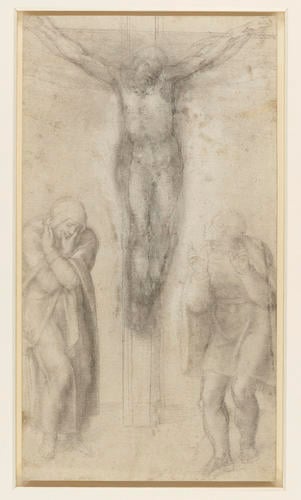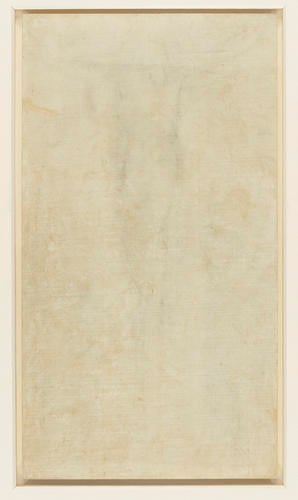-
1 of 253523 objects
Christ on the Cross with the Virgin and St John c. 1560-64
Black chalk and white heightening | 38.2 x 21.0 cm (sheet of paper) | RCIN 912775

Michelangelo Buonarroti (Caprese 1475-Rome 1564)
Christ on the Cross between the Virgin and St John c. 1560-64

Michelangelo Buonarroti (Caprese 1475-Rome 1564)
Christ on the Cross between the Virgin and St John c. 1560-64


-
A black chalk drawing of the crucified Christ upon a T-shaped cross, flanked by the Virgin Mary on the left, and St John on the right.
In the last years of his life Michelangelo drew the Crucifixion repeatedly (see also RCIN 912761 and 912774), as a sustained and profoundly felt spiritual exercise. In addition to the two drawings at Windsor, there are four other complete drawings of the subject in the British Museum (two), the Ashmolean Museum, Oxford, and the Louvre, Paris, together with several fragments, preparatory sketches and copies of lost drawings. These very late drawings, together with two (or possibly three) sculptures of the Lamentation or Pietà, differ radically from Michelangelo’s earlier works, in which the body of Christ on the cross, or after death, is depicted as undefiled, even heroic. Those earlier works asserted Christ’s triumph over death; the later drawings and sculptures emphasise instead his sacrifice, and the death and dissolution of his material body.
In these drawings Michelangelo depicts the Crucifixion not as a narrative scene but as a symbol, and what began as a carefully drawn composition gradually became more indefinite as he repeatedly reworked the outlines of Christ. The arms are in several positions and the position of his head, first slumped onto the right side of his chest, was redrawn to loll onto his left shoulder, rendering his facial features barely discernible. The outlines of the torso, hips and legs were partially erased or scratched out and redrawn in black chalk and white bodycolour, and although a definitive line of the upper legs can be discerned, the lower legs are composed of several overlapping forms. By contrast the mourning figures of the Virgin and St John the Evangelist remained tightly defined in their lumpen, earthly forms. Their hunched attitudes are opposed, Christ’s mother static and lost in introspective grief, the Evangelist stepping forwards, raising his head and hands in lamentation. They stand close to the base of the Cross but are unable to reach out and touch it: earth-bound and material, they inhabit a separate realm from the vaporous form of Christ as Spirit. This is not due to imprecision of touch in Michelangelo’s old age: his reworking of the figure of Christ gave an entirely deliberate effect of indeterminacy, capturing the dissolution of the body as the soul leaves the material world at the moment of death and passes into a different realm.
The belief in salvation by faith alone (sola fide), rather than by good deeds or the mere avoidance of sin, was the core message of the Beneficio di Cristo, a treatise on Christ’s sacrifice on the Cross and the key text of the ‘Spirituali’ movement of the 1540s, which strongly informed Michelangelo’s late personal spirituality. Though by 1560 the movement had dissolved, its practice of meditation on the Crucifixion and on Christ’s blood seems to have had a lasting effect on Michelangelo. These late Crucifixions can best be characterised as graphic meditations on Christ’s sacrifice, just as the Lamentations of twenty years before had been meditations on the grace that flowed from his dead body (see RCIN 912769).
A copy of the drawing was at Christie's, 6 July 2021, lot 5; see P. Joannides, ‘Reworking and erasure in two drawings by the aged Michelangelo’, in Colnaghi Studies, no. 2, March 2018, p. 154, fig. 6.Provenance
Listed in George III's 'Inventory A', c. 1800-20, p. 47 'Michael Angelo, Fra: Bartolomeo, And: del Sarto &[c]' / Tom. III (c. 1802): '2-4. […] three different Studys of the Crucifixtion'. Earlier provenance unknown.
-
Medium and techniques
Black chalk and white heightening
Measurements
38.2 x 21.0 cm (sheet of paper)
Other number(s)